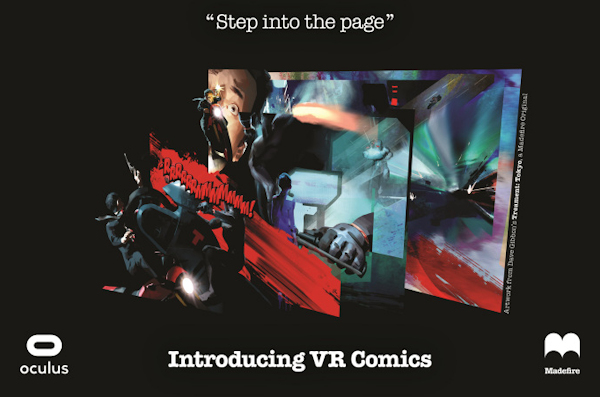[This story from TechCrunch suggests interesting research questions about how different strategies and techniques can increase presence in a format part way between symbolic text and photo-realistic audio-video. The story includes a 1:30 minute video.–Matthew]

Digital comics startup Madefire launches its first virtual reality app
Posted October 10, 2016 by Anthony Ha
When digital comics startup Madefire announced its latest funding round a few days ago, co-founder and CEO Ben Wolstenholme said the company was getting ready to move into virtual and augmented reality. He lived up to that promise in very short order, launching a preview app for Samsung’s Oculus-powered Gear VR platform and demonstrating it at New York Comic Con.
Wolstenholme has told me before that he’s trying to create a “native digital experience” that’s still recognizable as a comics-reading experience. Judging from the demo, that’s still true with the new VR experience — there’s music, sound effects and animation, but you’re still basically reading a comic.
Wolstenholme explained Madefire’s approach to VR as adding a third dimension to the experience. It’s not 3D comics, per se, but as a reader, you feel like you’re hovering in front of the comics panel.
He compared it alternately to theater and to cave paintings, and whichever metaphor you prefer, it makes for a much more immersive experience. When I tried it out, I felt as if I was occupying the same space as the art, which felt so much bigger and more overwhelming than when I’m reading it on my tablet or smartphone screen. (It helps that the comics can also include full 360-degree scenes.)
The Madefire authoring tool should make it relatively simple for creators to customize and control the three-dimensional aspect of their art, Wolstenholme said, but the company is also automatically upgrading its full library of comics: “We should have everything in there by Christmas.”
In the meantime, the demo app currently includes samples from a handful of titles, including DC’s Injustice: Year One and the Madefire original Mono: The Old Curiosity Shop (created by Wolstenholme and Liam Sharp).
I also had a chance to discuss the news to comics artist Dave Gibbons, who’s been working with Madefire for a few years now. He praised the Madefire format, including the new VR support, because it gives artists more control over the reading experience.
“Madefire sat in the sweet spot — it wasn’t about the gimmick, it was about the story,” Gibbons said, adding, “The [authoring] tool is available to everyone, so there’s no barrier to producing your own stuff. That feels like a glorious thing to me.”
As the co-creator of Watchmen and The Secret Service (adapted into the movie Kingsman: The Secret Service), Gibbons has seen comics’ stories and characters moving into other media. He said that comics have “quite recently become used as a prototype or pitching tool for movies.” With Madefire’s new formats, comics can still serve as a springboard of sorts, while also allowing writers and artists to explore new technologies and new ways to keep readers engaged.
“I suppose I’m at the time of life where I feel like I’ve seen it all, so it’s exciting to see something that is fresh and new and still engaging,” Gibbons said.